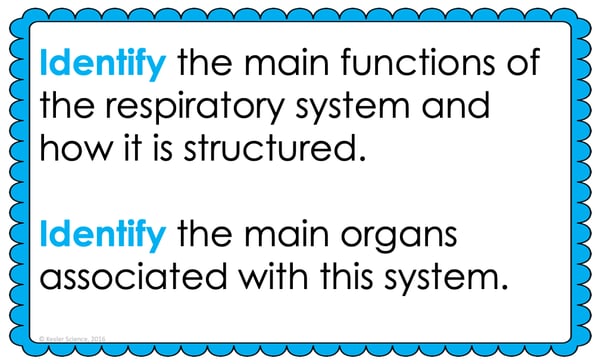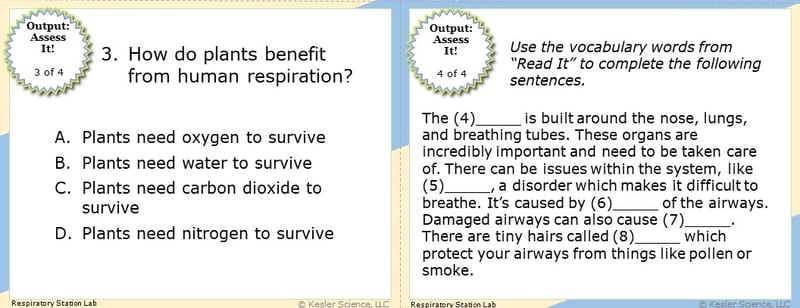Respiratory System Lesson Plan - A Complete Science Lesson Using the 5E Method of Instruction
By the end of this lesson about the respiratory system, students will be able to identify the main functions of the respiratory system and how it is structured. They'll also be able to identify the main organs associated with this system. Each of our lessons is designed using the 5E method of instruction to ensure maximum comprehension by the students. This well-thought out unit does the heavy lifting, giving teachers easy-to-implement, highly engaging lesson plans.
This blog will walk you through each of the steps and activities of the Respiratory System 5E Lesson Plan.
ENGAGEMENT
Objective Introduction
At the beginning of the lesson, the class will do a Think-Pair-Share to discuss the objective.
Class Activity
- The plastic tubing should be clean before being used. Have the students draw the apparatus as you demonstrate capacity.
- Fill a sink with about 10-12 cm of water.
- Fill the plastic bottle all the way to the top.
- Turn the bottle upside down into the sink without losing any water from the bottle.
- Push one end of the plastic tubing about 4-6 cm into the bottle about.
- Have one student take a deep breath and blow into the other end of the tubing to displace the water in the bottle with air.
- Mark the level of water with a dry erase marker.
Student Activity
- What is happening when the student blows into the tubing?
- Why is this happening?
- What would happen if another student tried this experiment?
- What does this tell you about the student’s lung capacity?
- Let another student try, so that you have a comparison.
- If you have enough equipment, let other students try this experiment. Make sure to wipe off the tube with the alcohol between students and rinse out the tubing.
- Tell students they will be learning about the structure and function of the respiratory system, which allowed them to do this experiment today.

The teacher will help to clear any misconceptions about the respiratory system. A major misconception is that students do not understand the connection between the respiratory and circulatory system.
Estimated Class Time for the Engagement: 20-30 minutes
EXPLORATION
This student-centered station lab is set up so students can begin to explore the respiratory system. With nine stations in total, you can introduce the respiratory system to your middle school students in a variety of ways! Four of these stations are considered input stations where students will learn new information about the respiratory system, and four of the stations are output stations where students will be demonstrating their mastery of the lesson's material. A bonus station offers challenges for your early finishers and independent learners. You can read more about how I set up the station labs here.
Watch It!
At this station, students will be watching a short video explaining the respiratory system. Students will then answer questions related to the video and record their answers on their lab station sheet. For example: Explain what the process of respiration is. List at least six of the organs or structures which exist in the respiratory system. Why do we breath harder when we exercise?
Read It!
This station will provide students with a one-page reading about bronchitis. Afterwards, there will be four follow-up questions for the students to answer to demonstrate their comprehension of the reading material.
Explore It!
Students will be working in pairs to better understand the respiratory system. In this station, students will be observing diagrams pertaining to the respiratory system. As they explore, students will record their observations on their lab sheet.
Research It!
The research station will allow students to explore an interactive webpage that has students take a scientific approach to understanding the respiratory system. Students will be instructed to complete a few tasks and record answers on their lab sheets.
Organize It!
Students at this station will match the sets of cards. Students will read a series of cards and will match the descriptions to their correct locations on the diagram. Once students have completed their organization, the teacher will check their understanding and comprehension of the material.
Illustrate It!
Your visual students will love this station. Students are to create and label a diagram that shows the structures of the respiratory system.

Write It!
Students who can answer open-ended questions about the lab truly understand the concepts that are being taught. At this station, the students will be answering three task cards: Explain the respiratory system, including the structures involved and the function of the system. How does the respiratory system work directly with the circulatory system? Plants give off oxygen as part of photosynthesis. Explain the impact of this process on humans.
Assess It!
The Assess It station is where students will go to prove mastery over the concepts they learned in the lab. The questions are set up in a standardized format with multiple choice answers. Some questions include: Which is not a part of the respiratory system? How does the diaphragm aide in breathing? How do plants benefit from human respiration? The Respiratory system works directly with the _____ system to exchange oxygen and carbon dioxide in the lungs.

Challenge It! - Bonus Station
Early finishers and advanced students will love the extension activities in this station. Four activity choices offer them ways to expand their learning through mini-games and mini-projects.
Estimated Class Time for the Exploration: One or two 45-minute class periods
EXPLANATION
The explanation activities will become much more engaging for your class once they’ve completed the exploration station lab. During the explanation piece of the lesson, the teacher will be clearing up any misconceptions their students may have about the respiratory system with a variety of materials. These materials include on-level and modified versions of the interactive presentation (may be used individually or projected), anchor charts, and paper or digital interactive notebook activities.
The students will also be interacting with their journals while taking notes from the PowerPoint. If you have students that need modified notes, the 5E lessons come equipped to help give every student access to the lesson.
Estimated Class Time for the Exploration: Two or three 45-minute class periods
ELABORATION
The elaboration section of the 5E method of instruction gives students choices that allow them to prove they’ve mastered the concepts behind the lesson. When students are given a choice, they’re much more enthusiastic and invested in the project than they are when their teachers choose their projects for them. There are a total of nine choices to demonstrate understanding of the respiratory system. A separate set of choices that offer more teacher support are also available for students that need them. Rubrics guide students to doing their best work and assist in grading.

Estimated Class Time for the Elaboration: Two or three 45-minute class periods (can also be used as an at-home project)
EVALUATION
The final piece of the 5E model is to evaluate your students' comprehension. Included in every 5E lesson is a homework assignment, assessment, and modified assessment. Research has shown that homework needs to be meaningful and applicable to real-world activities in order to be effective. When possible, I like to give open-ended assessments to truly gauge the student’s comprehension.
Estimated Class Time for the Elaboration: One 45-minute class period
DOWNLOAD THE FULL LESSON NOW
Download Over $100 in FREE Resources
For Middle School Science
Simply create a login below and gain immediate access to a selection of our Kesler Science product line worth $100 - for FREE. There's a full version of every product type! You'll also join tens of thousands of middle school science teachers who receive timely tips and strategies straight to their inbox.







